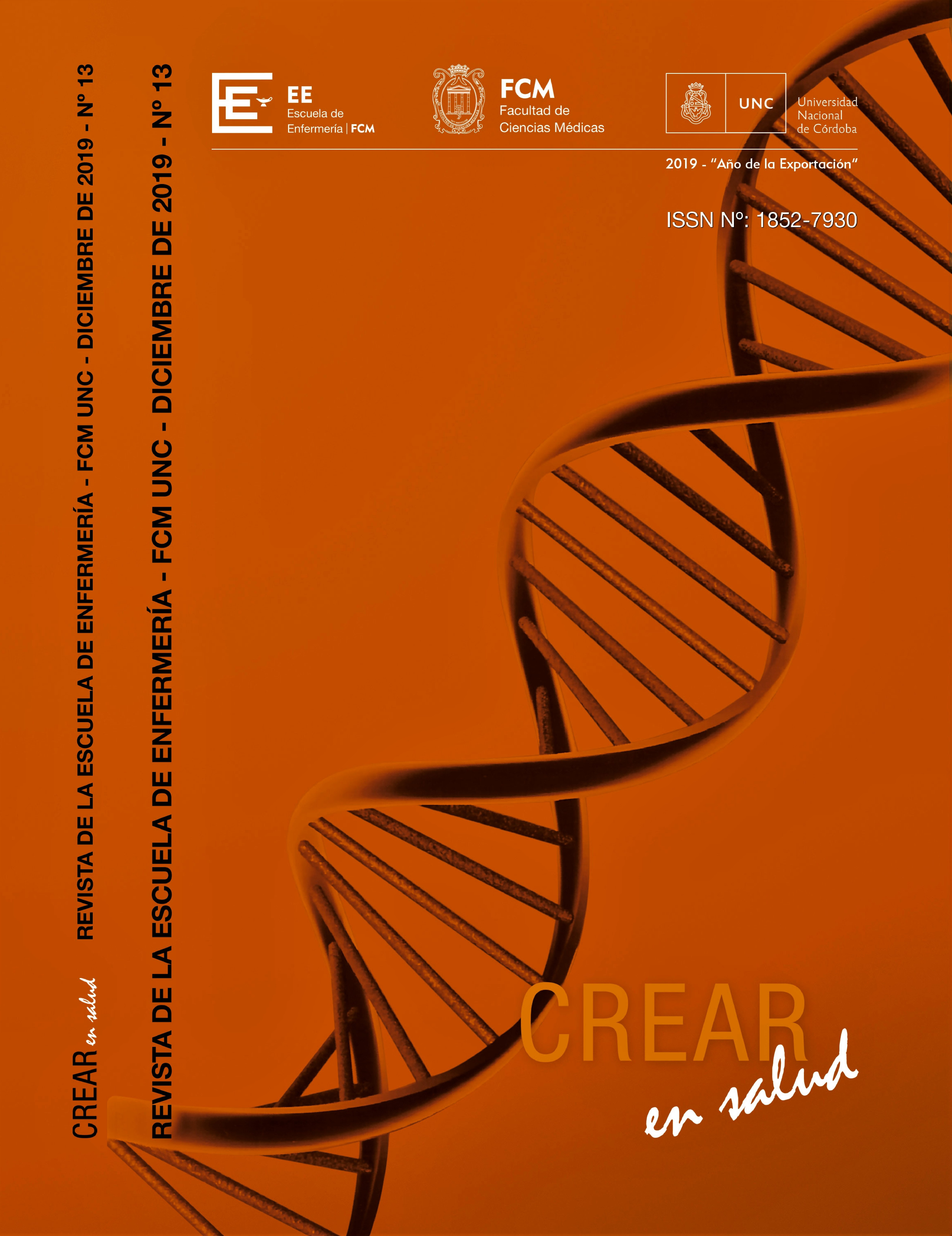WORKLOAD. PERCEPTION AND REPERCUSSION ON THE HEALTH OF NURSES AND ON THE ORGANIZATION OF PROVINCIAL PUBLIC HOSPITALS OF CÓRDOBA.
Keywords:
Workload, Perceptions and RepercussionsAbstract
Introduction: work overload is a worldwide concern. In cities, mortality from diseases linked to stress, to physical, emotional overload, where nurses are included, increases. The National Institute for Occupational Safety and Health (2005), understands the workload as the set of activities or interventions carried out by the nurse in response to the demands of care of people and the family. Objective: to compare the perception of the Nurses' workload, its impact on health and the organization of the general hospitalization services of Public Hospitals of Córdoba. Methodology: type of study, transversal. Comparative, analytical. Study variables: Workload perception. Perceptions: referred to the recognition, interpretation and significance of the workload. Impact of the workload related to the care provided to the organization, the life and personal health of nurses. Population: 107 Nurses. Source: primary; Technique: survey, Instrument: validated and adapted self-administered form. Ethical-legal issues required for the study were completed. Results: regarding the Perception expressed by the professionals in the institutions studied, there are three distinct stages: a) People who do not express the feeling of workload; b) Those that express burden related to double-work days and due to an increase in the demand for patients affecting daily actions in all professional, care, organization, performance and family aspects and c) workload due to the social situation of the patients, the lack of work elements, the disorganization at work also differ according to sex. Regarding the repercussions, the interviewees consider that there are physical ones such as headaches, joint and lumbar pain, insomnia and stress; reluctance, disinterest, lack of commitment. In those related to Care it has to do with the quality of care provided, it has an impact on family, emotional and social life. Conclusion and Discussion: the findings are consistent with results presented by previous studies according to which to take into account that the number of Nursing personnel does not solve the problem affects reducing adverse events including falls and infections. According to Neffa (2009) the impact of the workload is related to a physical load and the effort that causes fatigue, accidents and occupational diseases. The feminization of the Nursing profession, although day by day changes with the incorporation of more men, it is still very marked and affects the family and social life of nurses; Concerns for children and dependents, work overload and multi-employment affect the professional and work development of nurses.
References
Alexandre Pazetto, B.; Suely Sueko, S.; Viski Zanei, I.; Yamaguchi Whitaker. (2003). Carga de trabalho de enfermagem e sua relação com a gravidade dos pacientes cirúrgicos em UTI.
Amparo Bernat, A.; Abizanda Campos, B.; Cubedo Rey, M.; Quintana Bellmunt, J.; Sanahuja Rochera, E.; Sanchís Muñoz, J.; Montserrat Soriano Canuto, R.;Tejedor López, A.; Yvars Bou, M. (2005). Nursing Activity Score (NAS). Nuestra experiencia con un sistema de cómputo de cargas de enfermería basado en tiempos. Elsevier, 16(04), 4.
Arias-Rivera, S.; Sánchez-Sánchez, M. M.; Fraile-Gamo, M. P.; Patiño-Freire, S.; Pinto-Rodríguez, V.; Conde-Alonso, M. P.; Ferguson, N. D.; Frutos-Vivar, F. (2013). Adaptación transcultural al castellano del Nursing Activities Score. 24(01).
Carmona-Monge, F. J. (2013). Análisis de la utilización de la escala Nursing Activities Score en dos UCIS Españolas. Rev Esc Enferm USP.
Dalri, R.; Cássia de Marchi Barcellos, S.; Almeida, L.; Mendes, A.; Oliveira Cruz, & Robazzi, M.; Carmo Cruz, L. (2014). Carga horaria de trabajo de los enfermeros y su relación con las reacciones fisiológicas de estrés. Revista Latino-Americana de Enfermagem, 22(6), 959-965. Recuperado de: https://dx.doi.org/10.1590/0104-1169.3292.2503
Ducci, A.; Padilha Katia Grillo, J. ( 2008). Nursing activities score: estudio comparativo de la aplicacion retrospectiva y prospectiva en una investigación. 21(4).
England, P.; Budig Michelle, J. y Folbre, N. (2002). Wages of virtue: The relative pay of care work. En: Social Problems, vol. 49, N° 4.
Ferreira Queijo, A.; Kátia Grillo Padilha, K. (2009). Nursing Activities Score (NAS): Adaptación Transcultural. Rev. Enfermagen 43.
Folbre, N. (2006). Measuring care: Gender, empowerment, and the care economy. En: Journal of Human Development, vol. 7, N° 2.
Fondo de las Naciones Unidas para la Infancia UNICEF. (2007). Estado mundial de la Infancia 2007. La mujer y la infancia. El doble dividendo de la igualdad de género. ISBN-13: 978-92-806-4066-3 Consultado en https://www.unicef.org/spanish/sowc07/docs/sowc07_chap3_sp.pdf
Lake, E. T.; Cheung, R. B. (2006). Are patient falls and pressure ulcers sensitive to nurse staffing. Rev. Enfermagen 28(6).
Miranda, D. R.; Nap, R.; De Rijk, A.; Schaufeli, W.; Iapichino, G. (2003). Tiss Working Group. Therapeutic Intervention Scoring System. Nursing activities score. 31(2).
Padilha, K. G.; Sousa, R. M.; Garcia, P. C.; Bento, S. T.; Finardi, E. M.; Hatarashi, R.H. (2010). Nursingworkload and staff allocation in an intensive care unit: A pilot study according to Nursing Activities Score (NAS). Enfermagem 26(2).
Regina, M.; Yatsue Conishi, L.; Rapone Gaidzinski, R. (2007). Nursing Activities Score - NAS como instrumento para medir la Carga de Trabajo. Enfermagem 41(3).
Ramírez-Elizondo, N.; Paravic-Klijn, T. & Valenzuela-Suazo, S. (2013). Riesgo de los turnos nocturnos en la salud integral del profesional de enfermería. Índex de Enfermería, 22(3), 152-155. Recuperado de: https://dx.doi.org/10.4321/S1132-12962013000200008
Razavi, S. y Staab, S. (2010). Mucho trabajo y poco salario. Perspectiva internacional de los trabajadores del cuidado. En: Revista Internacional del Trabajo, vol. 129, nro. 4.
Stafseth, S. K.; Solms, D.; Breda, I. S. (2011). The characterisation of workloads and nursing staff allocation in intensive care units: a descriptive study using the Nursing Activities Score for the first time in Norway. Rev. Enfermagem 27(5).
Downloads
Published
Issue
Section
License

This work is licensed under a Creative Commons Attribution-NonCommercial 4.0 International License.



